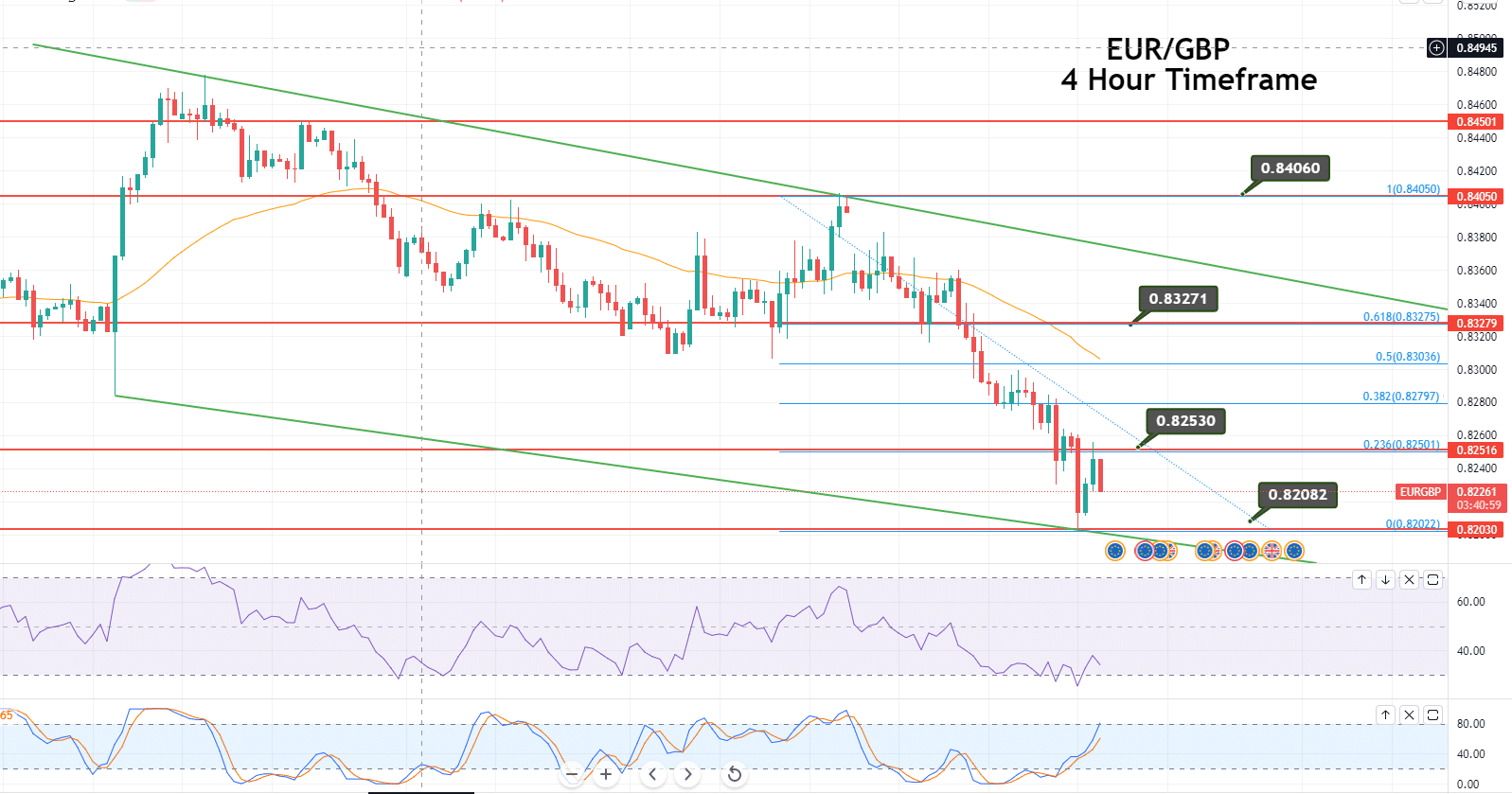EUR/GBP Slips to 0.8235 – Can Fibonacci Retracement Drive Reversal?
Please note that we are not authorised to provide any investment advice. The content on this page is for information purposes only.
- The European economy is expected to face the burden of the knock-on effects of higher energy prices, which might further drive inflation.
- EUR/GBP currency pair is trading at 0.8241 and consolidating in the range between 0.8202 and 0.8267.
- EUR/GBP is trading at 0.8230 level, heading lower towards an immediate support level of 0.8203 level.
In the early European session, the EUR/GBP currency pair failed to stop its previous long bearish rally. The pair remained depressed for the sixth consecutive day on Monday. It prolonged its recent decline from the 0.8400 round-figure mark. However, its downward trend could be attributed to fears that the crisis in Ukraine could slow down the Eurozone’s recovery. Thus, it was seen as the key factor that kept the EUR/GBP pair under pressure.
Refer to our trading guides to enhance your forex trading skills.
Knock-on Effects of Higher Energy Prices
The European economy is expected to face the burden of the knock-on effects of higher energy prices, which might further drive inflation. Furthermore, Philip Lane, the European Central Bank’s senior economist, anticipates that the Ukraine conflict will have a 0.3 percent to 0.4 percent impact on the Eurozone’s GDP this year. This has increased the risk of stagflation while pressuring the European currency. Hence, contributing to the EUR/GBP currency pair losses. On the other hand, the stronger US dollar exerted pressure on the pound sterling, helping the EUR/GBP currency pair limit losses.
Ukraine and Russia Geopolitical Tensions in Highlights
The EUR/GBP currency pair is trading at 0.8241 and consolidating in the range between 0.8202 and 0.8267. Despite the so-called peace negotiations, the risk-off sentiment persisted during Monday’s European session. That’s because the tensions between Ukraine and Russia remain high. Russia continues to shell Ukraine despite the recent deal, disrupting the evacuation. The Times also reported the statements to match UK Defense Chief Admiral Sir Tony Radakin, implying increased geopolitical tensions between Kyiv and Moscow.
According to the Times, Russia’s main forces have been “decimated,” and taking over Ukraine is not inevitable. According to the report, Defense Chief Radakin also believed that Russia might “turn up the violence” with more indiscriminate killing. It’s more indiscriminate violence in response to opposition. Thus, fears that the conflict in Ukraine would slow the Eurozone’s recovery were cited as a major driver in the EUR/GBP pair’s decline.
As a result, S&P 500 futures are down 1.60 percent. Whereas, the 10-year US Treasury rates are down 2.5 basis points (bps) to 1.69 percent. On the flip side, Japan’s Nikkei 225 on the other hand, has been losing nearly 3.0% each day, dipping to levels last seen in November 2020.
Euro Weakens amid Spillover Effect
The European economy is projected to take the burden of the spillover effects in rising energy prices. It might fuel inflation even further. Furthermore, Philip Lane, the European Central Bank’s chief economist, predicted that the Ukraine crisis would reduce the Eurozone’s GDP by 0.3 percent to 0.4 percent this year. This has made stagflation even more likely, and it has also put more pressure on the euro.
On Friday, the Russian military assaulted Europe’s largest nuclear power station in Ukraine, the Russia-Ukraine conflict even further. Furthermore, the Zaporizhzhia nuclear power station was captured by Russian military forces. Moreover, media sources claim that gas flow from Russia to Europe has halted. The new geopolitical developments have shattered hopes that the European Central Bank will normalize monetary policy at its March 10 meeting. Another factor contributing to the EUR/GBP pair’s persistent decline was identified.
The prolonged strength of the US dollar, on the other hand, weighs on the British pound. It may offer support to the EUR/GBP currency pair. On Monday, the US dollar was higher, with the euro dropping to a new 22-month low against the greenback. Besides, the dollar also fell against the Yen, Swiss franc, and Pound all hitting multi-year lows. The long-running war in Ukraine has raised commodity and safe-haven asset prices. It has raised fears of a stagflationary shock that would mostly hit Europe.
What’s Next?
Looking ahead, the fundamental backdrop should continue to weaken the euro. It’s implying that the EUR/GBP cross will continue to lose ground. Traders will also keep a close eye on the escalating Ukraine conflict.

EUR/GBP price forecast –Daily Technical Levels
Support Resistance
0.83601 0.84209
0.83221 0.84437
0.82613 0.85045
Pivot Point: 0.83829
EUR/GBP price forecast – Symmetrical Triangle Breakout
The EUR/GBP is trading at 0.8230 level, heading lower towards an immediate support level of 0.8203 level. A breakout of 0.8203 level exposes the EUR/GBP price towards the next support level of 0.8150 level. Continuation of the downtrend can expose the EUR/GBP price further lower until 0.8125 and 0.8085 levels.
Since the market is already in the oversold zone, the odds of bullish reversal remain strong, especially above the support level of 0.8203 level. On the 4-hour chart, the EUR/GBP pair is likely to face resistance at 0.8250 level. A break above 0.8250 (23.6% Fibo level), the EUR/GBP price can soar towards 61.8% retracement level at 0.8325.
The 50-day exponential moving average is likely to provide resistance at the 0.8305 level. Thus, we should look for a buy trade over the 0.8202 level and vice versa. All the best, and stay tuned for more updates!





